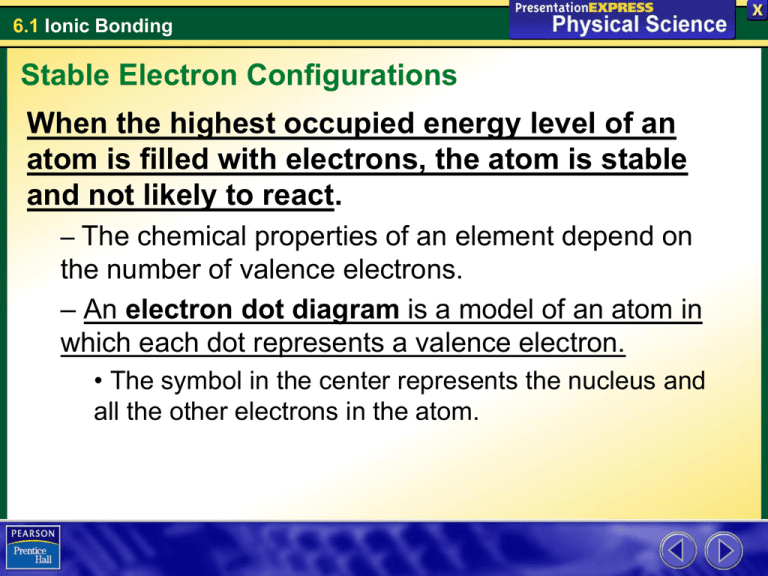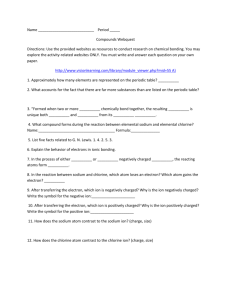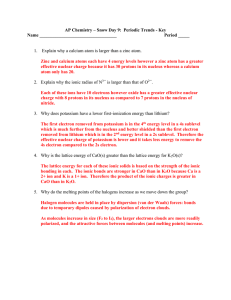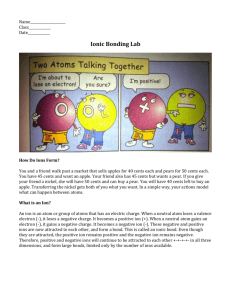Stable Electron Configurations 6.1 Ionic Bonding - ib
advertisement

6.1 Ionic Bonding Stable Electron Configurations When the highest occupied energy level of an atom is filled with electrons, the atom is stable and not likely to react. – The chemical properties of an element depend on the number of valence electrons. – An electron dot diagram is a model of an atom in which each dot represents a valence electron. • The symbol in the center represents the nucleus and all the other electrons in the atom. 6.1 Ionic Bonding Stable Electron Configurations 6.1 Ionic Bonding Stable Electron Configurations 6.1 Ionic Bonding Stable Electron Configurations 6.1 Ionic Bonding Stable Electron Configurations 6.1 Ionic Bonding Stable Electron Configurations 6.1 Ionic Bonding Stable Electron Configurations 6.1 Ionic Bonding Stable Electron Configurations 6.1 Ionic Bonding Stable Electron Configurations 6.1 Ionic Bonding Stable Electron Configurations 6.1 Ionic Bonding Stable Electron Configurations Noble gases are the most stable elements • The highest occupied energy level is completely filled. • Elements tend to react to achieve electron configurations similar to those of noble gases. • Some elements achieve stable electron configurations by transferring electrons between atoms 6.1 Ionic Bonding Ionic Bonds Transfer of Electrons • A chlorine atom has 1 electron less than an argon atom. • Adding 1 electron would create a stable configuration. • A sodium atom has 1 more electron than a neon atom. • Removing 1 electron would give sodium a stable configuration. 6.1 Ionic Bonding Ionic Bonds When sodium reacts with chlorine, an electron is transferred from each sodium atom to a chlorine atom. Each atom ends up with a more stable electron arrangement than it had before the transfer. 6.1 Ionic Bonding Ionic Bonds When sodium reacts with chlorine, an electron is transferred from each sodium atom to a chlorine atom. Each atom ends up with a more stable electron arrangement than it had before the transfer. 6.1 Ionic Bonding Ionic Bonds When sodium reacts with chlorine, an electron is transferred from each sodium atom to a chlorine atom. Each atom ends up with a more stable electron arrangement than it had before the transfer. 6.1 Ionic Bonding Ionic Bonds When sodium reacts with chlorine, an electron is transferred from each sodium atom to a chlorine atom. Each atom ends up with a more stable electron arrangement than it had before the transfer. 6.1 Ionic Bonding Ionic Bonds Formation of Ions If an atom gains or loses an electron, the number of protons is no longer equal to the number of electrons. • The atom is not neutral • An atom that has a net positive or negative electric charge is called an ion • charge is represented by a plus or a minus sign 6.1 Ionic Bonding Ionic Bonds The ion that forms when a chlorine atom gains an electron has 17 protons and 18 electrons. • • • • This ion has a charge of 1–. The symbol for the ion is written Cl1–, or Cl– for short. An ion with a negative charge is an anion. Anions are named by using part of the element name plus the suffix –ide. Thus, Cl– is called a chloride ion. 6.1 Ionic Bonding Ionic Bonds A sodium ion has 11 protons and 10 electrons. • • • • The sodium ion has a charge of 1+. The symbol for the ion is written Na1+, or Na+ for short. An ion with a positive charge is a cation. A cation uses the element name, as in the sodium ion. 6.1 Ionic Bonding Ionic Bonds Formation of Ionic Bonds • Opposite charges attract. • Chemical bond: the force that holds atoms or ions together as a unit. • Ionic bond: the force that holds cations and anions together. • Forms when electrons are transferred from one atom to another.






